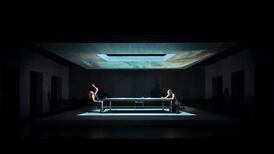Palimpsest
The Complex
★★★★★
Titles are often the last consideration for artists, a hurried decision demanded by the publicity team when the “working title” doesn’t quite work any more. In Palimpsest, David Bolger’s latest creation, the title isn’t just a label describing the contents but goes to the marrow of what the choreographer has created and how he has created it.
In a general sense a palimpsest is an object that has been reused for another purpose, like a manuscript that is washed clean and new words written over. Old layers are covered and barely discernible but still evident.
For his dance Bolger has taken events and people from Irish political and social history and created a layered overview of the first 100 years of the Republic. And if history is why we are who we are, then he finally questions how these events have created our present identity. Are the layers of the past visible in our present?
Walking into the performing space, the audience pass by cardboard boxes labelled as costumes and props from previous productions by CoisCéim – instantly, more layers of meaning are suggested, and continue throughout the performance.
READ MORE
The boxes themselves are reminiscent of the company’s 2000 duet Boxes, a playful homage to cardboard. The television screen looks exactly like the one used in Uncle Ray. Did Ballads, a dance about the Famine, feature these suitcases and small pile of earth? Didn’t Bolger choreograph a dance for hurleys in Heartbeat of Home? The Perspex boxes are unlikely to have been repurposed from the ones used in Knots, but still.
Similarly, historical episodes are summoned from memories. The infamous “living way beyond our means” television broadcast by Taoiseach Charles Haughey is played alongside dancers measuring Charvet shirts, popping champagne bottles and showing off yachts and racehorse saddles. Earlier Eavan Boland’s poem Our Future Will Become the Past of Other Women is recited by Máire Ní Ghráinne, reminding the audience of the more wholesome and lasting political legacy of the suffragettes as their names are projected on to the floor.
Projections of photos and film add context to the proceedings, but the physical is always paramount. The brutalised bodies of Derry’s Bloody Sunday are shown thrashing with angst and terror, the undertow of enforced emigration with almost apathetic softness, and the hard-partying of the Celtic Tiger era with pumping in-the-moment hedonism.
The latter is hilariously interrupted by Ní Ghráinne dressed as Margaret O’Donoghue, also known as Maggie with the Crucifix, a one-time regular feature on Dublin streets, dressed in black with a beret and a cross. Later Justine Cooper dances a solo based on the moves of Mary Dunne (Dancing Mary), who sang and danced on O’Connell Street.
These collective and individual memories are presented without a narrative arc or chronology: Bolger is happy to let each viewer create individual histories. But he is not entirely dispassionate. Anger is clearly evident in the duet by Alex O’Neill and Mateusz Szczerek set to the Anglo Irish Bank tapes, where executives talk nonchalantly about losses of tens of billions of euro.
Just as history is written collectively, so too is art, and Bolger acknowledges the contribution of more than 50 artists and technicians who have brought Palimpsest into being, Denis Clohessy’s ever-changing score being a particular highlight.
Palimpsest runs at the Complex, Dublin 7, until Saturday, March 23rd, as part of St Patrick’s Festival













